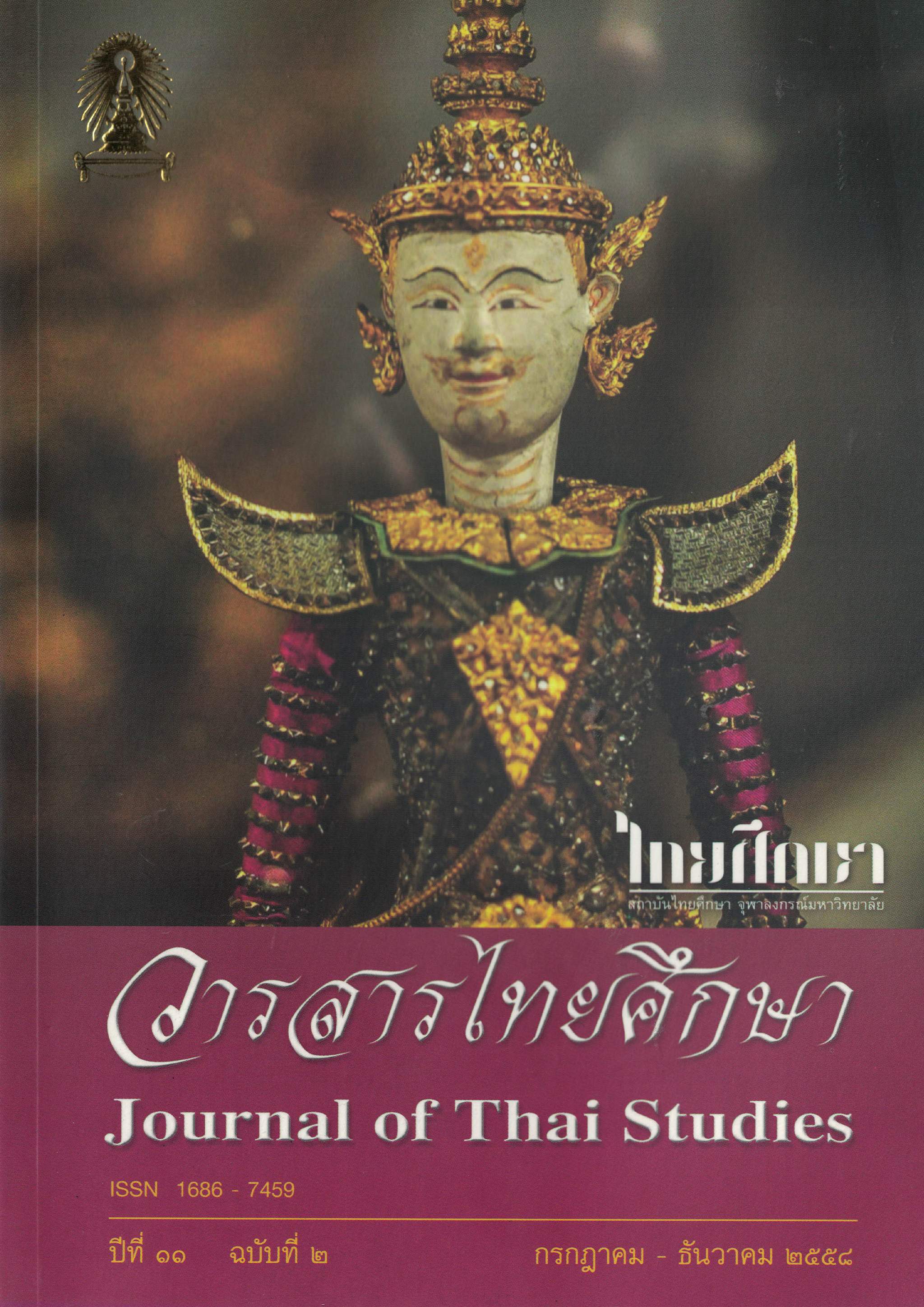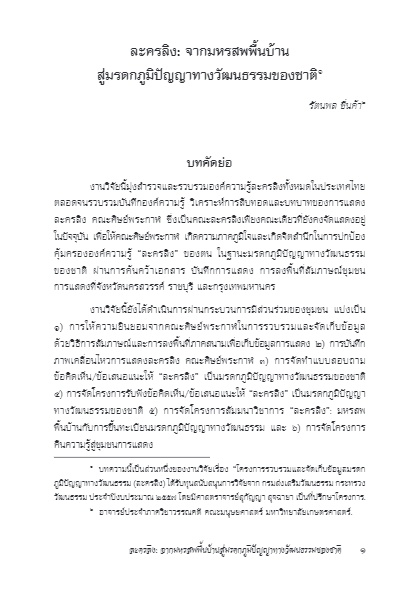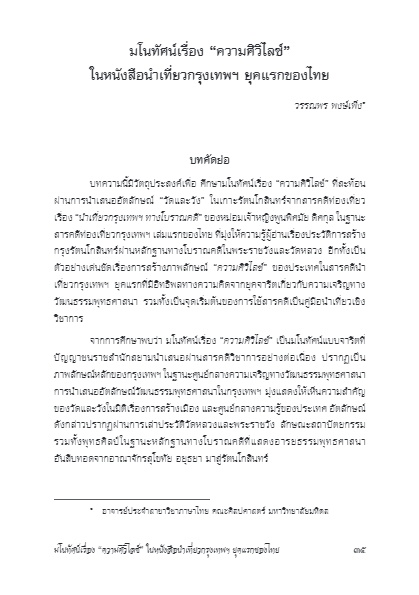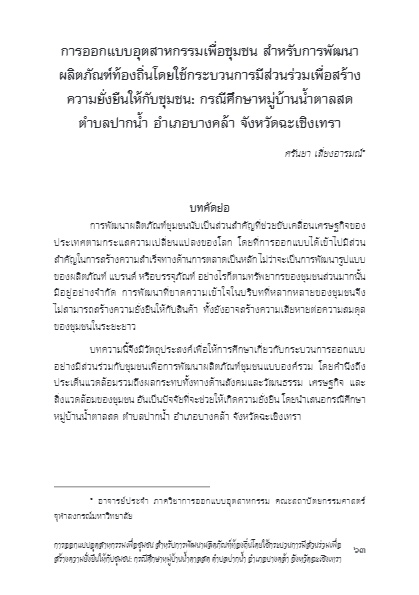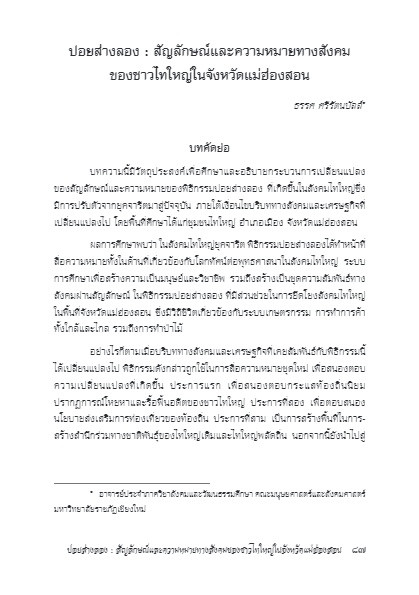วารสารไทยศึกษา - ปีที่ 11 ฉบับที่ 2
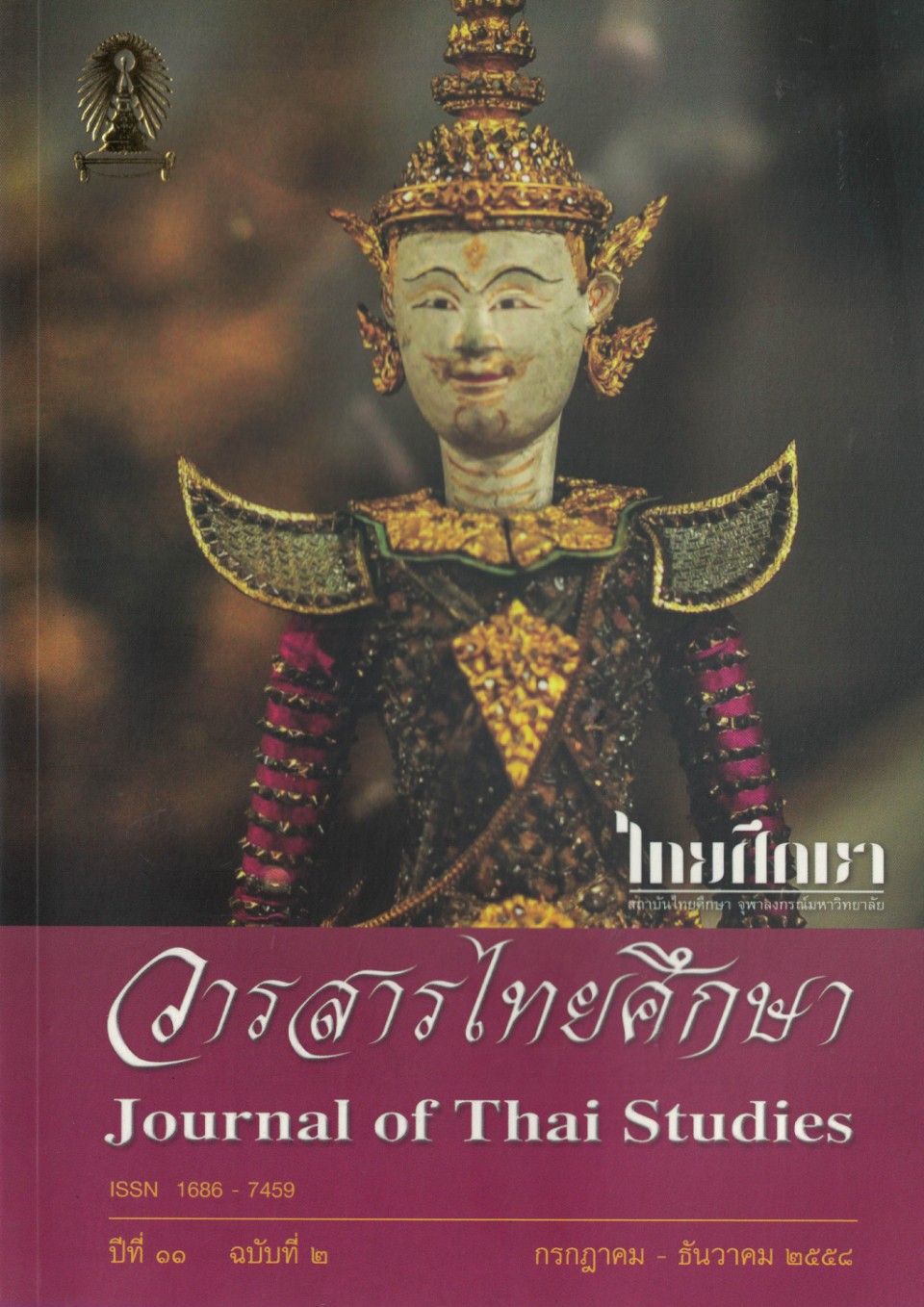
1) ละครลิง : จากมหรสพพื้นบ้านสู่มรดกภูมิปัญญาทางวัฒนธรรมของชาติ / รัตนพล ชื่นค้า
2) มโนทัศน์เรื่อง “ความศิวิไลซ์” ในสารคดีท่องเที่ยวกรุงเทพฯ ยุคแรกของไทย / วรรณพร พงษ์เพ็ง
3) การออกแบบอุตสาหกรรมเพื่อชุมชนสำหรับการพัฒนาผลิตภัณฑ์ท้องถิ่นโดยใช้กระบวนการมีส่วนร่วมเพื่อสร้างความยื่นยืนให้กับชุมชน : กรณีศึกษาหมู่บ้านน้ำตาลสด ตำบลปากน้ำ อำเภอบางคล้า จังหวัดฉะเชิงเทรา / ศรันยา เสี่ยงอารมณ์
4) ปอยส่างลอง : สัญลักษณ์และความหมายทางสังคมของชาวไทใหญ่ในจังหวัดแม่ฮ่องสอน / ธรรศ ศรีรัตนบัลล์
5) ตัวตนของเมืองในล้านนา / ภูเดช แสนสา
ละครลิง : จากมหรสพพื้นบ้านสู่มรดกภูมิปัญญาทางวัฒนธรรมของชาติ
รัตนพล ชื่นค้า
บทคัดย่อ
งานวิจัยนี้มุ่งสำรวจและรวบรวมองค์ความรู้ละครลิงทั้งหมดในประเทศไทย ตลอดจนรวบรวมบันทึกองค์ความรู้ วิเคราะห์การสืบทอดและบทบาทของการแสดงละครลิง คณะศิษย์พระกาฬ ซึ่งเป็นคณะละครลิงเพียงคณะเดียวที่ยังคงจัดแสดงอยู่ในปัจจุบัน เพื่อให้คณะศิษย์พระกาฬ เกิดความภาคภูมิใจและเกิดจิตสำนึกในการปกป้องคุ้มครององค์ความรู้ “ละครลิง” ของตน ในฐานะมรดกภูมิปัญญาทางวัฒนธรรมของชาติ ผ่านการค้นคว้าเอกสาร บันทึกการแสดง การลงพื้นที่สัมภาษณ์ชุมชนการแสดงที่จังหวัดนครสวรรค์ ราชบุรี และกรุงเทพมหานคร
งานวิจัยนี้ยังได้ดำเนินการผ่านกระบวนการมีส่วนร่วมของชุมชน แบ่งเป็น 1) การให้ความยินยอมจากคณะศิษย์พระกาฬในการรวบรวมและจัดเก็บข้อมูลด้วยวิธีการสัมภาษณ์และการลงพื้นที่ภาคสนามเพื่อเก็บข้อมูลการแสดง 2) การบันทึกภาพเคลื่อนไหวการแสดงละครลิง คณะศิษย์พระกาฬ 3) การจัดทำแบบสอบถามข้อคิดเห็น/ข้อเสนอแนะให้ “ละครลิง” เป็นมรดกภูมิปัญญาทางวัฒนธรรมของชาติ 4) การจัดโครงการรับฟังข้อคิดเห็น/ข้อเสนอแนะให้ “ละครลิง” เป็นมรดกภูมิปัญญาทางวัฒนธรรมของชาติ 5) การจัดโครงการสัมมนาวิชาการ “ละครลิง”: มหรสพพื้นบ้านกับการขึ้นทะเบียนมรดกภูมิปัญญาทางวัฒนธรรม และ 6) การจัดโครงการคืนความรู้สู่ชุมชนการแสดง
ผลการศึกษาพบว่า องค์ความรู้ละครลิงในประเทศไทยประกอบด้วยองค์ความรู้ของละครลิงคณะวัฒนาวานร คณะลิงไทยมั่นคง คณะดำรงศิลปวานร และคณะศิษย์พระกาฬ ปัจจุบันเหลือละครลิงคณะศิษย์พระกาฬเพียงคณะเดียวที่ยังคงจัดแสดงอยู่ และมีการสืบทอด องค์ความรู้ให้แก่สมาชิกในสายตระกูล โดยผู้ที่มีองค์ความรู้ละครลิงมากที่สุด คือนายปัญญา กันรอบรู้ และผู้สืบทอดองค์ความรู้ละครลิง ได้แก่ นายวัชระ กันรอบรู้ นางวัชรี กันรอบรู้ และนายประกิจ กันรอบรู้
สภาพปัจจุบันของการแสดงละครลิง คณะศิษย์พระกาฬได้รับความนิยมน้อยลงเมื่อเทียบกับอดีต แต่ยังคงมีบทบาทในด้านการให้ความบันเทิงและด้านพิธีกรรมการแก้บน ผลการวิจัยยังพบว่าปัจจัยที่ส่งผลคุกคามองค์ความรู้ละครลิงในปัจจุบันมี 3 ปัจจัย ได้แก่ ปัจจัยด้านผู้ถ่ายทอด ด้านผู้สืบทอด และด้านสภาพการแสดง
(ตีพิมพ์ใน วารสารไทยศึกษา ปีที่ 11 ฉบับที่ 2 (กรกฎาคม – ธันวาคม 2558) หน้า 1-33)
Monkey Show: From Folk Performance To National Intangible Cultural Heritage
Rattanaphon Chuenka
Abstract
This research aims to collect all available knowledge about the Monkey Show in Thailand, as well as analyze the role and sustainability of this art as part of Thailand’s Intangible Cultural Heritage. The work focuses on the troupe “Sisphrakarn”, the only existing Monkey Show troupe, in order to collect all available knowledge and help create a sense of pride and ownership among the people of Thailand and boost moral support to the troupe who plays an important role in supporting and sustaining the knowledge of the Monkey Show act. This study analyaes and traces the background and literary reviews of the history of Monkey act Show in the areas where this show has been active, such as in Nakornsawan, Rachaburi, and Bangkok.
This research is conducted through community participation: by 1) obtaining permission from the owner of the show to gather information and conduct public intervies, 2) receiving permission to film the show, and 3) collecting social opinions through the use of public questionnaires to entitle the show as Thailand’s Intangible Cultural Heritage. Moreover, during this project we have had the opportunity to organize a public hearing on the subject of “Monkey Show as Thailand’s Intangible Cultural Heritage” and a seminar, “Monkey Show: Folk performance and its submission as Thailand’s Intangible Cultural Heritage.” Lastly, the project also gives “Sisphrakarn” the opportunity to review and reestablish their knowledge about the performance by giving full support to the researcher.
The research has found there have been the different troupes of Monkey Shows in Thailand: Wattana Vanorn Troupe, Thaimankong Troupe, Damrong Silpa Vanorn Troupe and Sisphrakarn Troupe. However only is still Sisphrakarn running their show and passing knowledge among family members such as, Mr.Panya Kanrobru, and his heir and successors, Mr.Vatchara Kanrobru, Ms.Vatcharee Kanrobru and Mr.Prakit Kanrobru.
The current situation of the Monkey Show is in crisis. Sisphrakarn Troupe’s popularity has been significantly lessened compared to that of the past. The role of Monkey Show today presented themselves as 1) a form of entertainment and 2) as a present to fulfill one’s vow to the gods. The research has found that there are 3 factors to threaten with knowledge of Monkey Show: transmitter, successor and state of showing.
(Published in Journal of Thai Studies Volume 11 Number 2 (July – December 2015) Page 1-33)
บทความ / Full Text : Download
มโนทัศน์เรื่อง "ความศิวิไลซ์" ในสารคดีท่องเที่ยวกรุงเทพฯ ยุคแรกของไทย
วรรณพร พงษ์เพ็ง
บทคัดย่อ
บทความนี้มีวัตถุประสงค์เพื่อ ศึกษามโนทัศน์เรื่อง “ความศิวิไลซ์” ที่สะท้อนผ่านการนำเสนออัตลักษณ์ “วัดและวัง” ในเกาะรัตนโกสินทร์จากสารคดีท่องเที่ยวเรื่อง “นำเที่ยวกรุงเทพฯ ทางโบราณคดี” ของหม่อมเจ้าหญิงพูนพิศมัย ดิศกุล ในฐานะสารคดีท่องเที่ยวกรุงเทพฯ เล่มแรกของไทย ที่มุ่งให้ความรู้ผู้อ่านเรื่องประวัติการสร้างกรุงรัตนโกสินทร์ผ่านหลักฐานทางโบราณคดีในพระราชวังและวัดหลวง อีกทั้งเป็นตัวอย่างเด่นชัดเรื่องการสร้างภาพลักษณ์ “ความศิวิไลซ์” ของประเทศในสารคดีนำเที่ยวกรุงเทพฯ ยุคแรกที่มีอิทธิพลทางความคิดจากยุคจารีตเกี่ยวกับความเจริญทางวัฒนธรรมพุทธศาสนา รวมทั้งเป็นจุดเริ่มต้นของการใช้สารคดีเป็นคู่มือนำเที่ยวเชิงวิชาการ
จากการศึกษาพบว่า มโนทัศน์เรื่อง “ความศิวิไลซ์” เป็นมโนทัศน์แบบจารีตที่ปัญญาชนราชสำนักสยามนำเสนอผ่านสารคดีวิชาการอย่างต่อเนื่อง ปรากฏเป็นภาพลักษณ์หลักของกรุงเทพฯ ในฐานะศูนย์กลางความเจริญทางวัฒนธรรมพุทธศาสนา การนำเสนออัตลักษณ์วัฒนธรรมพุทธศาสนาในกรุงเทพฯ มุ่งแสดงให้เห็นความสำคัญของวัดและวังในมิติเรื่องการสร้างเมือง และศูนย์กลางความรู้ของประเทศ อัตลักษณ์ดังกล่าวปรากฏผ่านการเล่าประวัติวัดหลวงและพระราชวัง ลักษณะสถาปัตยกรรม รวมทั้งพุทธศิลป์ในฐานะหลักฐานทางโบราณคดีที่แสดงอารยธรรมพุทธศาสนา อันสืบทอดจากอาณาจักรสุโขทัย อยุธยา มาสู่รัตนโกสินทร์
(ตีพิมพ์ใน วารสารไทยศึกษา ปีที่ 11 ฉบับที่ 2 (กรกฎาคม – ธันวาคม 2558) หน้า 35-61)
The Concept of “Civilization” in the Early Bangkok Tourist Guide of Thailand
Vannaporn Phongpheng
Abstract
This article aims to analyze the concept of “civilization as” reflected by the representation of the identities of “State Temples and Palaces” on Rattanakosin Island from a documentary work entitled “Exploring Bangkok through archaeological tour” of M.C. Phunphitsamai Ditsakun. This book is the first Bangkok tourist guide influenced by conventional concept of civilization produced by the Siamese court that aimed to change Thais’ viewpoint “State about Temples and Palaces”, from being sacred spaces to being the center of Buddhist civilization. It is clear that this book is the exemplar of how civilization knowledge was constructed through the lens of an elite scholar in the early Bangkok tourism period, as well as the beginning of Bangkok tourism based on academic knowledge.
The study reveals that the concept of civilization is a conventional concept appearing in Thai elites’ works which has been used through times. In such a context, Buddhist Civilization is a prominent aspect of Thai civilization appearing in this sort of work. The image of Bangkok as a “Buddhist City” is the outstanding image in this book. The significance of Thai Buddhism in this term is portrayed as a tool for creation of Buddhist city and the establishment of state temples for learning by Thais. The identities of Buddhist culture are represented by the narration of the historical backgrounds. of state temples, palaces, and Buddhist architecture. The characteristics of Buddhist arts also portrays the continuous Buddhist civilization of Thai kingdoms from Sukhothai, Ayutthaya to the Rattanakosin period.
(Published in Journal of Thai Studies Volume 11 Number 2 (July – December 2015) Page 35-61)
บทความ / Full Text : Download
การออกแบบอุตสาหกรรมเพื่อชุมชนสำหรับการพัฒนาผลิตภัณฑ์ท้องถิ่นโดยใช้กระบวนการมีส่วนร่วมเพื่อสร้างความยื่นยืนให้กับชุมชน : กรณีศึกษาหมู่บ้านน้ำตาลสด ตำบลปากน้ำ อำเภอบางคล้า จังหวัดฉะเชิงเทรา
ศรันยา เสี่ยงอารมณ์
บทคัดย่อ
การพัฒนาผลิตภัณฑ์ชุมชนนับเป็นส่วนสำคัญที่ช่วยขับเคลื่อนเศรษฐกิจของประเทศตามกระแสความเปลี่ยนแปลงของโลก โดยที่การออกแบบได้เข้าไปมีส่วนสำคัญในการสร้างความสำเร็จทางด้านการตลาดเป็นหลัก ไม่ว่าจะเป็นการพัฒนารูปแบบของผลิตภัณฑ์ แบรนด์ หรือบรรจุภัณฑ์ อย่างไรก็ตามทรัพยากรของชุมชนส่วนมากนั้นมีอยู่อย่างจำกัด การพัฒนาที่ขาดความเข้าใจในบริบทที่หลากหลายของชุมชนจึง
ไม่สามารถสร้างความยั่งยืนให้กับสินค้า ทั้งยังอาจสร้างความเสียหายต่อความสมดุลของชุมชนในระยะยาว
บทความนี้จึงมีวัตถุประสงค์เพื่อให้การศึกษาเกี่ยวกับกระบวนการออกแบบอย่างมีส่วนร่วมกับชุมชนเพื่อการพัฒนาผลิตภัณฑ์ชุมชนแบบองค์รวม โดยคำนึงถึงประเด็นแวดล้อมรวมถึงผลกระทบทั้งทางด้านสังคมและวัฒนธรรม เศรษฐกิจ และสิ่งแวดล้อมของชุมชน อันเป็นปัจจัยที่จะช่วยให้เกิดความยั่งยืน โดยนำเสนอกรณีศึกษาหมู่บ้านน้ำตาลสด ตำบลปากน้ำ อำเภอบางคล้า จังหวัดฉะเชิงเทรา
(ตีพิมพ์ใน วารสารไทยศึกษา ปีที่ 11 ฉบับที่ 2 (กรกฎาคม – ธันวาคม 2558) หน้า 63-85)
Industrial Design for Community in Support of Local Product Development through a Community-driven Participatory Approach for Sustainability: The Case Study of Sugar Village, Pak Nam, Bang Khla, Chachoengsao Province
Saranya Siangarom
Abstract
In relation to current global challenges, local product development is now considered a vital economic driving force for Thailand. At the same time, design plays an important role in marketing success, from branding, to packaging, and to other aspects of new product development. However, as community products are often made from finite resources and through inefficient modes of production, this scenario may cause long-term negative impact on the community, especially including the exploitation of cultural and ecological values.
This article aims to demonstrate the participatory design process employed in local product development through a case study of The Sugar Village, Pak Nam, Bangkhla, Chachoengsao Province. Various key aspects of sustainability – social, cultural, economic, and environmental – are taken into consideration.
(Published in Journal of Thai Studies Volume 11 Number 2 (July – December 2015) Page 63-85)
บทความ / Full Text : Download
ปอยส่างลอง : สัญลักษณ์และความหมายทางสังคมของชาวไทใหญ่ในจังหวัดแม่ฮ่องสอน
ธรรศ ศรีรัตนบัลล์
บทคัดย่อ
บทความนี้มีวัตถุประสงค์เพื่อศึกษาและอธิบายกระบวนการเปลี่ยนแปลงของสัญลักษณ์และความหมายของพิธีกรรมปอยส่างลอง ที่เกิดขึ้นในสังคมไทใหญ่ซึ่งมีการปรับตัวจากยุคจารีตมาสู่ปัจจุบัน ภายใต้เงื่อนไขบริบททางสังคมและเศรษฐกิจที่เปลี่ยนแปลงไป โดยพื้นที่ศึกษาได้แก่ชุมชนไทใหญ่ อำเภอเมือง จังหวัดแม่ฮ่องสอน
ผลการศึกษาพบว่า ในสังคมไทใหญ่ยุคจารีต พิธีกรรมปอยส่างลองได้ทำหน้าที่สื่อความหมายทั้งในด้านที่เกี่ยวข้องกับโลกทัศน์ต่อพุทธศาสนาในสังคมไทใหญ่ ระบบการศึกษาเพื่อสร้างความเป็นมนุษย์และวิชาชีพ รวมถึงสร้างเป็นชุดความสัมพันธ์ทางสังคมผ่านสัญลักษณ์ ในพิธีกรรมปอยส่างลอง ที่มีส่วนช่วยในการยึดโยงสังคมไทใหญ่ในพื้นที่จังหวัดแม่ฮ่องสอน ซึ่งมีวิถีชีวิตเกี่ยวข้องกับระบบเกษตรกรรม การทำการค้าทั้งใกล้และไกล รวมถึงการทำป่าไม้
อย่างไรก็ตามเมื่อบริบททางสังคมและเศรษฐกิจที่เคยสัมพันธ์กับพิธีกรรมนี้ได้เปลี่ยนแปลงไป พิธีกรรมดังกล่าวถูกใช้ในการสื่อความหมายชุดใหม่ เพื่อสนองตอบความเปลี่ยนแปลงที่เกิดขึ้น ประการแรก เพื่อสนองตอบกระแสท้องถิ่นนิยม ปรากฏการณ์โหยหาและรื้อฟื้นอดีตของชาวไทใหญ่ ประการที่สอง เพื่อตอบสนองนโยบายส่งเสริมการท่องเที่ยวของท้องถิ่น ประการที่สาม เป็นการสร้างพื้นที่ในการสร้างสำนึกร่วมทางชาติพันธุ์ของไทใหญ่เดิมและไทใหญ่พลัดถิ่น นอกจากนี้ยังนำไปสู่การสร้างชุดความสัมพันธ์ทางสังคมในรูปแบบใหม่ที่สัมพันธ์กับสภาพสังคมและเศรษฐกิจในปัจจุบัน ดังกล่าวมาสะท้อนให้เห็นกระบวนการปรับตัวของพิธีกรรมปอยส่างลอง เพื่อให้สามารถรับใช้สังคมในช่วงเวลาที่เปลี่ยนผ่านจากโลกจารีตสู่โลกสมัยใหม่ได้เป็นอย่างดี
(ตีพิมพ์ใน วารสารไทยศึกษา ปีที่ 11 ฉบับที่ 2 (กรกฎาคม – ธันวาคม 2558) หน้า 87-112)
The Social Meanings of the Poysanglong Ceremony of the Tai Yai People in Maehongson Province
That Sriratanaban
Abstract
This article aims to analyze and explain the evolving meaning and function of the Poysanglong Ceremony in the Tai Yai community, which has undergone social and economic transitions from the traditional period up to the present day. The subject of the study is the Tai Yai community in Muang district, Maehongson Province.
The study finds that, in the traditional period, the Poysanglong Ceremony served such purposes as: signifying the Tai Yai people’s beliefs in Buddhism; providing means to education and occupational skills training for Tai Yai males; and establishing social relationships and cohesion within the Tai Yai community in Maehongson province, whose livelihood depended upon agriculture, forestry and trade.
With the evolving socio-economic environment, the meaning and function of the Poysanglong Ceremony has also undergone transformation. At the present day, the Ceremony mainly functions in the following ways: catering to the emerging trends of localism and nostalgia among the Tai Yai people; to promote local tourism; strengthening the consciousness of the ethnic identity of both the local Tai Yai people and the Tai Yai migrants; and creating new forms of social relationships which correspond to the changes in modern society.
(Published in Journal of Thai Studies Volume 11 Number 2 (July – December 2015) Page 87-112)
บทความ / Full Text : Download
ตัวตนของเมืองในล้านนา
ภูเดช แสนสา
บทคัดย่อ
ตัวตนของเมืองในล้านนายุคจารีต ประกอบขึ้นด้วยหัวใจสำคัญ คือ “เจ้า” “พุทธ” (พราหมณ์) และ “ผี” มีการจัดระบบตัวตนทางจินตภาพซ้อนทาบทับไปกับระบบตัวตนทางกายภาพ ตัวตนของเมืองผ่านระบบเจ้ามีการจัดแบ่งปริมณฑลของเมืองและเวียงออกเป็นส่วนต่างๆ โดยให้คุ้มหลวงหอคำเวียงแก้วเป็นศูนย์กลางของเมือง ระบบพุทธ (พราหมณ์) มีการสร้างวัดสำคัญขึ้นเป็นองค์ประกอบของเมือง ทั้งวัดมิ่งเมือง วัดหัวข่วง วัดหลวงประจำเมือง และวัดสี่มุมเมือง มีการจัดระบบพระธาตุองค์สำคัญ ภายในเมืองหรืออาณาจักร ทั้งระบบบูชาพระธาตุประจำปีเกิด ระบบบูชาพระธาตุประจำพระเจ้าห้าพระองค์ และระบบบูชาพระธาตุสี่มุมเมือง (ระบบพระธาตุสี่จอม) การสร้างเวียงพระธาตุหรือเวียงทางศาสนา ตลอดจนสถาปนาพระธาตุประจำเมืองขึ้นตามภูเขาหรือพื้นที่สำคัญต่างๆ ระบบผีมีการจัดลำดับศักดิ์ของผีให้ควบคุมสังคมชุมชนระดับต่างๆ ภายในเมือง ทั้งจัดระบบผีรักษาทิศทั้ง 4 ของเมือง ระบบผีรักษาเวียงและพื้นที่สำคัญต่างๆ ของเมือง เสาอินทขีล (เสาหลักเมือง) ตลอดไปจนถึงไม้ใจเมืองหรือไม้หมายเมือง
(ตีพิมพ์ใน วารสารไทยศึกษา ปีที่ 11 ฉบับที่ 2 (กรกฎาคม – ธันวาคม 2558) หน้า 113-144)
City Identity of Lanna Kingdom
Phoodeit Saensa
Abstract
In the traditional era, the city identity of the Lanna Kingdom consisted of three essential aspects – King, Buddhism (or Brahmanism) and Spirit. The Lanna Kingdom had a systematic management of city identification through the institution of the King by considering the visual identity, together with physical identity, with the center of the city called Khum Luang Hor Kham Kaew. The kingdom separated the city areas to be many districts. For the Buddhist or Brahmin system, important temples were built as components of the city; for example, Ming Mueang temple, Hua Khuang temple, Si Mum Mueang temple and Luang temple in each city in the Lanna Kingdom.
For the important relics in the city or in the kingdom, there were systems of management by following relics birth years, systems for worshiping the relics of five god kings, and systems for worshiping the relics that were kept in temples that were locate at the four corners of city, called the Si Mum Mueang or the Si Chom Relics system. Construction and location of relics district temples or Buddhist/Brahmin districts were on mountains and important areas in the kingdom. For the spirit system, there was a gradation of spirits to control and cover each community level in the city. There was also a spirit systems to protect each corner of the four directions of the city, as well as guardian spirits for protecting inside the city and important areas in the city, such as a pillar (called Inthakhin Pillar), even including old trees in the city.
(Published in Journal of Thai Studies Volume 11 Number 2 (July – December 2015) Page 113-144)
บทความ / Full Text : Download
